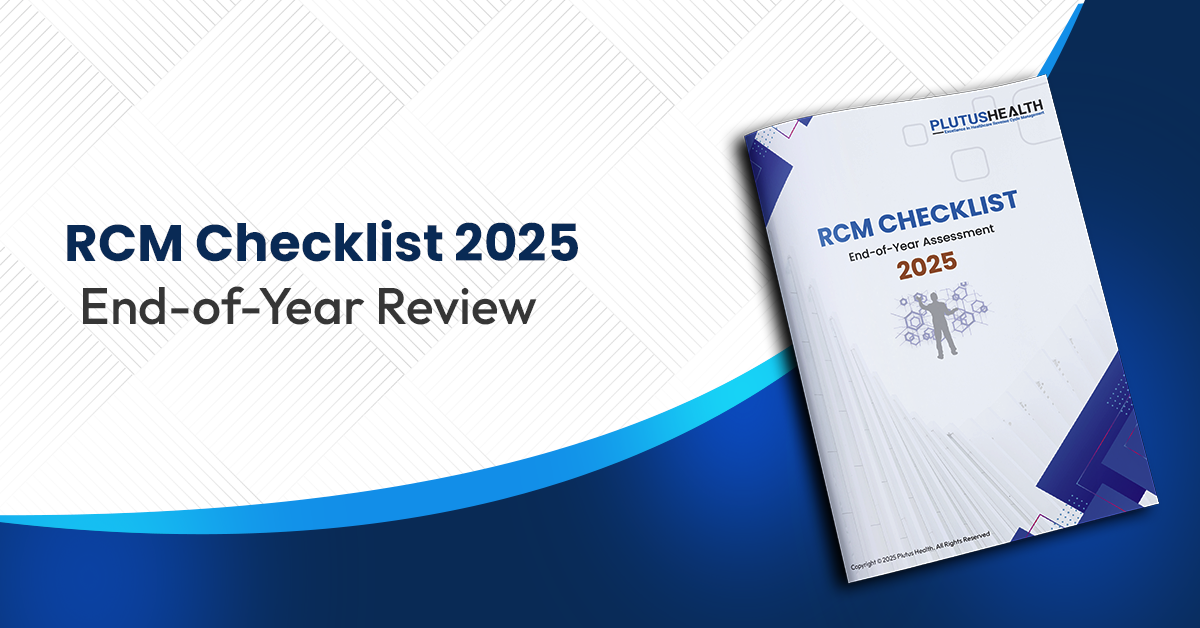Best Practices in Healthcare RCM by Stage
Medical providers will benefit greatly from following best practices in revenue cycle management. In this guide, our experts share their best practices for each stage of healthcare RCM. These steps will enable your organization to work smarter and increase profits.
In this blog:
- Pre-service stage best practices
- Service stage best practices
- Billing stage best practices
- Payment stage best practices
- Post-payment stage best practices
Healthcare Revenue Cycle Management Best Practices
Best practices for healthcare RCM center on good processes, communication, and technology. These pillars support all RCM stages, from eligibility checks through payment reviews. The best practices enable you to serve both patients and the bottom line.
Doing RCM well brings several benefits to your organization. Experts recommend best practices specific to the workflow of each stage: pre-service, service, billing, payment, and post-payment. (Explore more on the important steps and stages of RCM.)
RCM Best Practices for Pre-service Stage (Front End)
Best practices at the front-end RCM stage start with solid contracts. You’ll also need good technology to verify insurance eligibility. Then, determine the patient’s cost and collect it upfront. These steps streamline the entire RCM process.
Here are more details on best practices for the “pre-service” stage of RCM:
- Ensure you have appropriate contracts with insurance companies: Your organization must have economically sound contracts with insurance companies you work with to ensure you aren’t losing money in working with that payer. The contracts set all rates that that insurance company will pay for each medical service.
“The contracting piece in healthcare is going to set the stage for everything else after it,” says Jonathon Curlett, a long-time healthcare executive. “Any healthcare business needs to consistently be looking at the contracting side of the revenue cycle —to make sure they’re not missing out on opportunities and that they have appropriate market rates. That drives the rest of the revenue cycle.” - Automate insurance prior authorization and eligibility: Automating the eligibility verification process can save time and improve accuracy. That means fewer denied claims from insurance companies and other payers.
- Determine patient payment responsibility: With increased high-deductible insurance plans, patients are more often responsible for much of the bill. You should assess the patient’s portion before the service. You’ll also want to determine whether the patient’s insurance coverage considers the service in-network or out-of-network.
- Collect payment information upfront: It’s never too early to collect payment information from a patient, even before their appointment. That increases the chances of on-time payments and improves cash flow.
- Automate claim authorization: Insurance companies require pre-authorization for some specialist referrals and procedures. Medical providers should automate most of those authorization requests. That will save staff time and allow patients to understand quickly whether their insurance covers a procedure.
- Ensure your system performs all checks before service: You want to schedule patients as soon as possible after their request. But it’s also important to have time to perform all insurance authorization and other checks before the service.
- Start with clear communications with patients about costs: Before the first visit, you should establish clear communications with the patient. That should include simple and clear communications about the cost of any service. You should also inform the patient about co-pays, deductibles, and other out-of-pocket expenses. Patients appreciate that and are more likely to return to a provider if they fully understand all costs ahead of time. This can also prevent patient confusion and increase the chance of getting bills paid on time.
You can download a simple RCM Best Practices Cheat Sheet that lists best practices for each stage of RCM.
RCM Best Practices for Service Stage (Middle)
RCM best practices at the service stage include tracking service charges accurately and promptly. That leads to better charting and another chance at payment collection.
Experts offer more details on these best practices for the RCM service stage:
- Improve charge capture: Many providers lose revenue because they don’t accurately record the services they provide to a patient. Your organization’s staff should accurately track every service provided for a patient. Staff must also accurately enter that information into your charge system as soon as possible during or after the service to the patient.
- Conduct regular staff training: One of the best ways to ensure your organization’s processes are efficient and accurate is by training your staff. Your organization should implement regular education and training programs on your RCM processes. These should be not just for new employees but also for long-time employees. Ongoing training will ensure accurate processing. It will also allow your organization and staff to keep up with changes in health insurance and healthcare regulations.
- Improve documentation and charting: Beyond charge capture, ensure you have accurate documentation and charting for a patient. That includes patient information, insurance coverage, appointments, and treatments.
- Collect patient payment at the time of service: This step becomes easier if you’ve followed earlier best practices on good communication with the patient about costs and payment. Ideally, you’ll collect payment from the patient during the appointment or arrange other payment options. This practice will increase your ability to obtain all payments due from a patient. With the AnodynePay patient platform, the payment process becomes increasingly easy as there are convenient payment options provided for on-time payments, anywhere.
Main Stages of RCM
RCM Best Practices for Billing Stage (Middle)
At the billing stage in revenue cycle management, best practices include automated charge validation. Also, using bots can significantly improve medical coding. Technology plays a big role at this stage and in others.
Here are the details for best practices for the billing stage of RCM:
- Create charge validation process: A charge validation process will allow your organization to perform internal audits and use artificial intelligence and automated systems to verify that a charge fits the patient services you’ve documented. This process will enable you to fix any errors before submitting the claims. That lowers rejections and denials and saves your organization time and money.
- Use RPA bots for billing and coding: Robotic process automation bots can significantly improve medical coding and bill processes. Your organization can create the RPA bots to do medical coding and billing more efficiently and accurately than your staff can.
- Leverage auto-posting of payments: Software enables you to automatically post payments and avoid the burden of manually entering Explanation of Benefits information from insurance companies. These systems help to catch errors before sending statements to patients.
- Implement payment integrity process: Payment integrity means that your organization double-checks medical bills before it sends them to make sure they are accurate. Ensuring accuracy in the first medical bill saves staff time and resources from dealing with errors and rejections later. A payment integrity process may also include auditing of bills already sent, so your organization can determine the accuracy of bills and the effectiveness of its processes.
- Implement denial management process: Monitoring payer denials is critical for any provider to understand the reasons for the denials and adjust. Your organization should set up a system that monitors for consistent mistakes that lead to denials and corrects those mistakes before filing claims.
RCM Best Practices for Payment Stage (Back End)
At the back-end payment stage, RCM best practices focus on two things. First, ensure accurate billing with insurance companies or other payers. Second, regularly review the payer contracts to ensure good terms.
This further explains the best practices for the RCM payment stage:
- Immediately and accurately account for all payments: Your team must ensure that the accounting systems immediately and accurately account for all payments.
“Make sure there’s a reconciliation with bank accounts and cash flow,” Curlett says. “If that gets out of alignment, that can be a real auditing issue.” - Perform contractual allowance analysis: Your organization must continually analyze its contracts with payers and the rates that are part of those contracts. Your team should analyze how the rates within those contracts compare to rates other providers may get. You may want to renegotiate contracts with payers to get the best reimbursement rates and contract terms.
RCM Best Practices for Post-payment Stage (Back End)
Leading healthcare organizations use several best practices for the post-payment stage of RCM. They include a good accounts receivable process and coordinating secondary payers. Also, tracking your RCM KPIs lets you see how you’re doing.
Here are the details on best practices for the post-payment stage of RCM:
- Monitor and manage your accounts receivable balances: Your organization must monitor your accounts receivable balances and ensure you communicate with patients and payers about bills past due. You will want to note the totals in various categories of accounts receivable. That might include bills older than 45 or 90 days, for example. You’ll also want to record when a payer who normally pays within a certain amount of time has not paid within that time.
- Define and track your RCM KPIs: It’s very important that your organization tracks and responds to important RCM key performance indicators that show how its RCM processes are working. There are dozens of RCM KPIs. Especially important ones include denial rate, net collection rate and days revenue outstanding.
- Improve refund management: Your organization should establish processes to handle overpayments or erroneous payments promptly. Develop clear guidelines and protocols for identifying and processing refunds.
- Improve secondary and tertiary payer coordination: Many patients have insurance coverage from multiple providers. You should ensure proper billing of all insurance companies.
- Perform insurance company payment analysis: Your organization should analyze insurance payments beyond scouring for and fixing denials. It should also track when insurance companies and other payers make errors in denials or underpayments to your organization. Your organization should gather data and develop reports that detail those errors. You can then present that information to the insurance company during contract negotiations.
Hospital RCM Best Practices
Hospitals should follow general healthcare RCM best practices. In addition, they should adhere to the federal “No Surprises Act,” which took effect Jan. 1, 2022. This law prohibits medical providers from charging patients for out-of-network procedures at in-network hospitals.
Hospitals need to set up systems to ensure that doesn’t happen. That might mean creating a better approach to coordinating patient care so it’s all in their network. Also, hospitals can encourage physician enrollment in other healthcare plans.
An Overall Best Practice: The Right Structure and Technology
You should employ the right oversight structure through all RCM stages. That requires advanced technology that integrates with existing systems.
For example, your organization might use a business process improvement method like Lean Six Sigma. That can make your RCM as efficient and effective as possible. And your organization should use the most advanced software and technology to ensure you effectively assess and continually improve your RCM.
Why Outsourcing RCM Is the Best Practice
Most healthcare providers will benefit from outsourcing their revenue cycle management. Why? RCM specialists have special expertise and advanced technology. They can build an effective RCM system less expensively.
In more detail, RCM outsourcing providers offer the following:
- Expertise and specialization: The dedicated experts that an RCM provider employs have deep knowledge of all parts of RCM. That includes industry regulations, coding requirements, and billing practices. Outsourcing RCM means medical providers leverage the expertise of these professionals who focus solely on optimizing the provider’s revenue cycle.
- Scalability and flexibility: Outsourcing RCM means a medical provider can quickly scale up or down its RCM processes to meet its needs. That’s especially important as providers experience a patient surge or must adapt to changing industry requirements. RCM providers have the resources and infrastructure to handle any changes quickly and efficiently.
- Cost efficiency: Managing RCM effectively in-house can be expensive. It requires staff with expertise, special technology, continual training, and other resources. Outsourcing RCM eliminates these upfront expenses. Instead, medical providers can pay a single fee to an RCM provider (often based on a percentage of revenue collections).
- Easy access to advanced technology: RCM providers have developed advanced technology platforms, software and other tools that produce especially efficient RCM processes. They continue to invest in the newest technology that optimizes RCM, improves accuracy and speeds up the payment cycle. By outsourcing their RCM, medical providers can leverage this without additional cost.
Efficient Revenue Cycle Management Outsourcing
Plutus Health provides comprehensive, full-cycle RCM services. We lead the industry in understanding and using all RCM best practices. We use artificial intelligence, machine learning, and robotic process automation to offer custom solutions that seamlessly integrate with your existing systems, ensuring high-quality results without compromising service.
We help clients improve their accounts receivable collections. And we help them improve their overall RCM processes. Schedule a free RCM assessment today to start on the road to improving your revenue cycle and boosting your bottom line.
Liked the blog? Share it
FAQs


ABA providers are grappling with high staff turnover (up to 65%), rising burnout, administrative overload, and stagnant reimbursement rates. These challenges directly impact care continuity, clinical outcomes, and operational performance.


Operational inefficiency costs ABA teams up to 10 hours per staff member per week, contributing to burnout, denied claims, and longer accounts receivable (A/R) cycles. These inefficiencies ultimately result in reduced revenue and patient dissatisfaction.


Burnout leads to costly turnover, lower client retention, and decreased productivity. Recruiting and replacing a BCBA or RBT can cost up to $5,000 per hire, plus months of lost revenue and disruption to morale.


High-performing ABA organizations invest in clear career pathways for BCBAs and RBTs, align compensation with market benchmarks, and foster peer-led mentorship, flexible schedules, and wellness programs.


Automation tools like Plutus Health's Zeus streamline eligibility verification, denial management, and billing, reducing manual workloads by 5–10 hours weekly per clinician and improving clean claim rates by 95%.


Outsourcing revenue cycle management can improve collections, reduce denials by up to 30%, and free clinicians from billing-related admin tasks, resulting in better client care and financial outcomes.


One $200 million ABA network partnered with Plutus Health to automate eligibility and accounts receivable (A/R) processes. The result: $2M reduction in legacy A/R and a 97% Net Collection Rate.


By improving operational efficiency, investing in technology, and ensuring workforce stability, ABA leaders can align outcomes with reimbursement. Plutus Health supports this transition with scalable RCM and automation strategies.
FAQs


ABA therapy billing is the process of submitting claims to insurance or Medicaid for Applied Behavior Analysis services provided to individuals with autism or developmental disorders. It includes using correct CPT codes, proper documentation, and adherence to payer-specific policies.


Common CPT codes for ABA therapy in 2025 include:
- 97151 – Assessment and treatment planning
- 97153 – Direct therapy with the patient
- 97155 – Supervision and modification of behavior plan
- 97156 – Family adaptive training
- Always check with payers for any annual changes.


To bill Medicaid for ABA services, providers must ensure credentialing is complete, services are pre-authorized, and claims use the correct codes and modifiers. Medicaid requirements vary by state, so always follow state-specific billing rules.


Common ABA billing mistakes include:
- Incorrect or missing CPT codesplan
- Lack of documentation or treatment
- Uncredentialed providers rendering services
- Submitting duplicate or late claims


Without proper credentialing, providers can’t get reimbursed. Insurance and Medicaid require that BCBAs, RBTs, and organizations are credentialed and contracted. Delays in credentialing often cause revenue losses and claim rejections.
FAQs


CMS proposes a 2.4% increase in Medicare ASC payment rates, contingent on meeting ASCQR quality reporting requirements. Plutus Health helps ASCs meet these compliance benchmarks by integrating quality reporting data into RCM workflows, ensuring eligibility for full payment updates.


The ASC Covered Procedures List will expand by 547 procedures, including cardiology, spine, and vascular surgeries. Plutus Health supports expansion into new service lines by customizing RCM processes for high-acuity procedures, minimizing claim denials during the transition.


Site-neutrality narrows the payment gap with hospital outpatient departments, enhancing ASCs' cost-efficiency appeal. Plutus Health helps leverage this advantage in payer negotiations by providing performance dashboards and cost-justification analytics to secure stronger reimbursement terms.


Complex procedures increase denial risk and slow cash flow. Plutus Health's automation-first RCM model delivers 95%+ clean claim rates, reduces A/R days, and safeguards margins, even as your case mix becomes more complex.
FAQs


A hybrid RCM model combines in-house tasks like scheduling, intake, and patient communication with outsourced billing support for claims, denials, and A/R follow-up. Plutus Health enables this model with automation and expert teams.


Frequent CPT code updates, variable session lengths, high no-show rates, and sensitivity around patient collections make behavioral health billing uniquely challenging. Hybrid RCM helps strike a balance between compliance and patient care.


Tasks requiring patient interaction—like intake, eligibility checks, copay collection, and documentation—are best kept in-house, while backend processes can be outsourced.


Outsourcing denial management, claims scrubbing, and payment posting improves clean claim rates, reduces A/R days, and scales capacity without adding staff.


Plutus Health delivers 97%+ clean claim rates, AI-powered denial prediction, and 48-hour claim turnaround. Our hybrid RCM solutions provide behavioral health CFOs with visibility and control, while enhancing financial performance.
FAQs


Payment complexity, high out-of-pocket costs, increasing denials, and value-based care requirements are pushing providers toward more transparent, tech-supported payment systems.


Patients now act like consumers. They expect clear cost estimates, simple bills, digital payment options, and flexible financing.


AI, automation, and digital tools streamline estimates, reduce denials, support payment plans, and allow faster collections through mobile and online payments.


Complex billing questions, insurance confusion, and financial stress require a compassionate approach. Advocates guide patients and protect trust in clinical care.


Plutus Health supports providers with AI-driven denial prevention, predictive analytics, digital payment tools, patient financing, and a seamless platform, such as AnodynePay.


















































